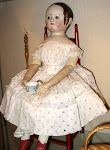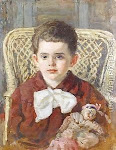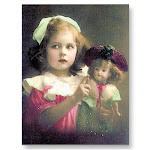***************************
With all of the excitement of the holiday season and the new traditions that have made their way into modern culture, it can be difficult to remember the origin of these holidays and the importance of the original traditions. All too often, Halloween is associated with costumes and candy but, in its early days, the significance of Halloween held great importance throughout Scotland, Ireland and Britain. Sadly, over time, these traditions have been forgotten.

Halloween actually started out as Samhain, a ceremony celebrated among Celts and their ancestors. In the country year, Samhain marked the end of the winter solstice as well as a prosperous harvest, when the herders led the cattle and sheep down from their summer hillside pastures to the shelter of stable and byre. The hay that would feed them during the winter must be stored in sturdy thatched racks, tied down securely against storms. Those destined for the table were slaughtered, after being ritually devoted to the gods in pagan times.

 All the harvest must be gathered in -- barley, oats, wheat, turnips, and apples -- for come November, the witches would blast every growing plant with their breath, blighting any nuts and berries remaining on the hedgerows.
All the harvest must be gathered in -- barley, oats, wheat, turnips, and apples -- for come November, the witches would blast every growing plant with their breath, blighting any nuts and berries remaining on the hedgerows.
"Donkey Ride: William Bouguereau ca. 1878
******************************************
 "Peter, Peter..Pumpkin Eater"
"Peter, Peter..Pumpkin Eater"
****************************************
Other old traditions have survived to this day; lanterns carved out of pumpkins and turnips were used to provide light on a night when huge bonfires were lit, and all households let their fires go out so they could be rekindled from this new fire; this was believed to be good luck for all households. The name "Jack-O-Lantern" means "Jack of the Lantern, " and comes from an old Irish tale. Jack was a man who could enter neither heaven nor hell and was condemned to wander through the night with only a candle in a turnip for light. Or so goes the legend...









 George Frederic Watts "Little Red Riding Hood"
George Frederic Watts "Little Red Riding Hood"





 The wind began to switch / The house, to pitch / And suddenly the hinges started to unhitch / Just then the Witch / To satisfy an itch / Went flying on her broomstick, thumbing for a hitch!
The wind began to switch / The house, to pitch / And suddenly the hinges started to unhitch / Just then the Witch / To satisfy an itch / Went flying on her broomstick, thumbing for a hitch!







******************************************
Peat and wood for winter fires were stacked high by the hearth. It was a joyous time of family reunion, when all members of the household worked together baking, salting meat, and making preserves for the winter feasts to come. The endless horizons of summer gave way to a warm, dim and often smoky room; the symphony of summer sounds was replaced by a counterpoint of voices, young and old, human and animal. For early Europeans, this time of the year marked the beginning of the cold, lean months to come; the flocks were brought in from the fields to live in sheds until spring. Animals were slaughtered, and the meat preserved to provide food for the winter. The last gathering of crops was known as "Harvest Home, "
It celebrated with fairs and festivals.
 "Peter, Peter..Pumpkin Eater"
"Peter, Peter..Pumpkin Eater"****************************************
Other old traditions have survived to this day; lanterns carved out of pumpkins and turnips were used to provide light on a night when huge bonfires were lit, and all households let their fires go out so they could be rekindled from this new fire; this was believed to be good luck for all households. The name "Jack-O-Lantern" means "Jack of the Lantern, " and comes from an old Irish tale. Jack was a man who could enter neither heaven nor hell and was condemned to wander through the night with only a candle in a turnip for light. Or so goes the legend...


"Trick or treat" as it is practiced in the U. S. is a complex custom believed to derive from several Samhain traditions, as well as being unique to this country. Since Irish immigrants were predominantly Catholic, they were more likely to observe All Soul's Day. But Ireland's folk traditions die hard, and the old ways of Samhain were remembered. The old tradition of going door to door asking for donations of money or food for the New Year's feast, was carried over to the U. S. from the British Isles.


Hogmanay was celebrated January 1st in rural Scotland, and there are records of a "trick or treat" type of custom; curses would be invoked on those who did not give generously; while those who did give from their hearts were blessed and praised. Hence, the notion of "trick or treat" was born (although this greeting was not commonly used until the 1930's in the U. S.). The wearing of Halloween Costumes is an ancient practice; villagers would dress as ghosts, to escort the spirits of the dead to the outskirts of the town, at the end of the night's celebration.



Backward, turn backward, O Time, in your flight make me a child again just for to-night!~Elizabeth Akers Allen

Once upon a time there lived in a certain village a little country girl, the prettiest creature who was ever seen. This good woman had a little red riding hood made for her. It suited the girl so extremely well that everybody called her Little Red Riding Hood.
One day her mother, having made some cakes, said to her,
One day her mother, having made some cakes, said to her,
"Go, my dear, and see how your grandmother is doing, for I hear she has been very ill. Take her a cake, and this little pot of butter."

As she was going through the wood, she met with a wolf, who had a very great mind to eat her up, but he dared not, because of some woodcutters working nearby in the forest. He asked her where she was going. The poor child, who did not know that it was dangerous to stay and talk to a wolf, said to him, "I am going to see my grandmother and carry her a cake and a little pot of butter from my mother."
 George Frederic Watts "Little Red Riding Hood"
George Frederic Watts "Little Red Riding Hood"**********************************
"Does she live far off?" said the wolf
"Oh I say," answered Little Red Riding Hood; "it is beyond that mill you see there, at the first house in the village."
"Well," said the wolf, "and I'll go and see her too. I'll go this way and go you that, and we shall see who will be there first."
"Oh I say," answered Little Red Riding Hood; "it is beyond that mill you see there, at the first house in the village."
"Well," said the wolf, "and I'll go and see her too. I'll go this way and go you that, and we shall see who will be there first."

This greeting card depicts a ritual of divination found in folklore from the USA and the British Isles. The young girl hopes to catch a glimpse of her future husband by looking into a mirror on a darkened room at Hallowe'en.


Eye of newt, and toe of frog, wool of bat, and tongue of dog. Adder's fork, and blind-worm's sting, lizard's leg, and owlet's wing. For a charm of powerful trouble, like a hell-broth boil and bubble. -William Shakespeare


Snap-Apple Night, painted by Irish artist Daniel Maclise in 1833. It was inspired by a Halloween party he attended in Blarney,, Ireland, in 1832. The caption in the first exhibit catalogue: There Peggy was dancing with Dan, while Maureen the lead was melting. To prove how their fortunes ran with the cards ould Nancy dealt in; There was Kate, and her sweet-heart Will, in nuts their true-love burning. And poor Norah, though smiling still. She'd missed the snap-apple turning. On the Festival of Hallow Eve.
 The wind began to switch / The house, to pitch / And suddenly the hinges started to unhitch / Just then the Witch / To satisfy an itch / Went flying on her broomstick, thumbing for a hitch!
The wind began to switch / The house, to pitch / And suddenly the hinges started to unhitch / Just then the Witch / To satisfy an itch / Went flying on her broomstick, thumbing for a hitch!
Once upon a time...Next to a great forest there lived a poor woodcutter with his wife and his two children. The boy's name was Hansel and the girl's name was Gretel.
He had but little to eat, and once, when a great famine came to the land, he could no longer provide even their daily bread.
He had but little to eat, and once, when a great famine came to the land, he could no longer provide even their daily bread.
"Let's sit down and eat our fill," said Hansel. "I'll eat from the roof, and Gretel, you eat from the window. That will be nice and sweet for you."
Hansel had already eaten a piece from the roof and Gretel had eaten a few round windowpanes, and she had just broken out another one when she heard a gentle voice calling out from inside:
Nibble, nibble, little mouse "Who is nibbling at my house"?
Hansel had already eaten a piece from the roof and Gretel had eaten a few round windowpanes, and she had just broken out another one when she heard a gentle voice calling out from inside:
Nibble, nibble, little mouse "Who is nibbling at my house"?



Pixie, kobold, elf, and sprite, all are on their rounds tonight; In the wan moon's silver ray, thrives their helter-skelter play.

Once upon a midnight dreary, while I pondered, weak and weary. Over many a quaint and curious volume of forgotten lore. While I nodded, nearly napping, suddenly there came a tapping, as of some one gently rapping, rapping at my chamber door."'Tis some visitor," I muttered, "tapping at my chamber door — Only this, and nothing more."

Open here I flung the shutter, when, with many a flirt and flutter, in there stepped a stately raven of the saintly days of yore; Not the least obeisance made he; not a minute stopped or stayed he; But, with mien of lord or lady, perched above my chamber door —Perched upon a bust of Pallas just above my chamber door — Perched, and sat, and nothing more.

Then this ebony bird beguiling my sad fancy into smiling,By the grave and stern decorum of the countenance it wore."Though thy crest be shorn and shaven, thou," I said, "art sure no craven. Ghastly grim and ancient raven wandering from the Nightly shore —Tell me what thy lordly name is on the Night's Plutonian shore!" Quoth the Raven, "Nevermore."













































.jpg)































































































%E2%80%99+by+Dante+Gabriel+Rossetti,+1868..jpg)













